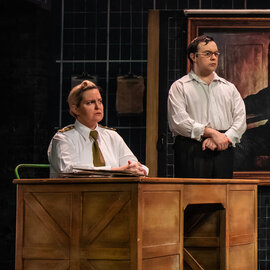A blue plaque for Hester
In the last year, my theatre trips have been dominated by Operation Mincemeat, a comedy musical currently playing in the Fortune Theatre. The writing is clever, the songs are catchy, and it’s laugh-a-minute funny, but it can also be solemn and moving.
The show is based on the real-life wartime deception operation of the same name. British spies took a corpse, dressed him as a pilot with a suitcase full of fake documents, and let him wash up on the coast of Spain – feeding the Nazis false information about the planned invasion of Sicily.
Making a musical about Second World War espionage is a delicate balancing act. You want to write jokes so the audience have fun, but you don’t want to trivialise the horror and suffering of war. I think the show handles this pretty well – there’s lots of laughter, but every so often the theatre falls silent as we’re reminded that “these men’s lives are not a joke”. (This line was added in the West End transfer, and it’s one of my favourites.)
The emotional high point of the show is Dear Bill, a solo in which a quiet secretary (Jak Malone, Christian Andrews) writes a fake love letter for the fictional Allied pilot. All the jokes fade away, and we realise the letter isn’t as fake as we thought. It’s a moving and powerful number, and I still cry every time I hear it.
The secretary is Hester Leggatt, a real woman who really did work on Operation Mincemeat. She was the head of the MI5 secretaries, and she wrote the letter that went in the pilot’s briefcase. Several of the lines in the song are taken directly from her words. (“Darling, why did we go and meet in the middle of a war, such a silly thing for anybody to do.”)

Beautiful as it is, I don’t think Dear Bill can stand on its own. It shows us the pain in Hester’s heart; the grief of her lost lover; a tragedy she has kept from her coworkers – but that can’t be her whole arc. Nothing can ever bring Tom back, but we want to see her begin to heal.
That healing starts to come in the second act song Useful. Hester is talking to Jean Leslie, another MI5 secretary (Claire-Marie Hall, Holly Sumpton), about how they can both be useful even if their contributions aren’t recognised by the men in charge. The song calls back to Dear Bill, echoing its lyrics as Jean tells Hester how much she’s grown under Hester’s supervision. It’s a beautiful moment of realisation, as Hester sees how much Jean looks up to her.
The song has a sad ring of truth – Hester wasn’t considered important by history, and SpitLip (the writers of the show) struggled to find much information about her. Unlike the men whose histories were extensively documented and recorded, Hester died almost without trace.
But after falling in love with her, the show’s “Mincefluencer” fandom have been righting this wrong – there’s been an extensive investigation to learn more about her, and to uncover her life story. I haven’t been part of this, but I’ve been watching the #find-hester channel in the Discord, and the amount they’ve found is quite astounding.
One of the perennial topics is the idea of getting Hester a blue plaque to commemorate her life. It’s not clear whether she would qualify, and so this hasn’t happened. (Yet.)
But the other night I was sitting in the theatre, and I heard Jak sing the line “perhaps just a small plaque, something tasteful and small”. I thought of all the fan discussions, and I decided to take matters into my own hands.
I had some spare blue cross-stitch fabric from my Saturn V blueprint, and I have plenty of white thread. That’s basically a plaque, right? I started sketching out a design – blue plaques usually have the name of the person, their dates, and a line or two about why they’re worth remembering.
I already had her name, which is “Leggatt” with an “a” – at some point a transcription error had corrupted this to “Leggett” in the popular record, making her harder to track down. This error was found by the fandom research. That research also gave me her dates (1905–1995), and then I used one of Jean’s lines as her description (“a timeless inspiration”).
For the letters themselves, I used two fonts. Her name is written in Needlework Gazette’s Fancy Alphabet (three strands of cross-stitch), and the rest of the text is in StitchPoint’s Monaco (two strands of back-stitch). I planned out the rough shape in a spreadsheet, made a few adjustments to the spacing between letters, and then I stitched it up.
I mounted the piece in a 6″ hoop which I’d painted white, and I gave it to Jak on stage door a few weeks ago. I futzed a bit of the glue, but otherwise I’m pretty pleased with the result. I’m told that it now hangs backstage at the Fortune, among other pieces of fan art.

It’s not a garden or a grand royal park, but I hope Hester would like it all the same.